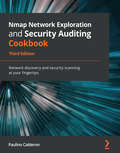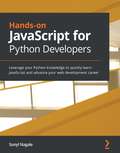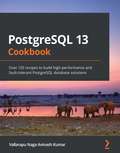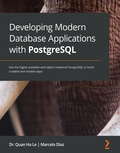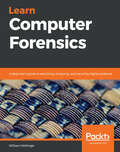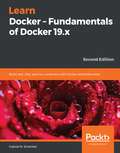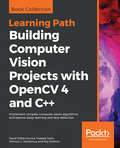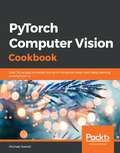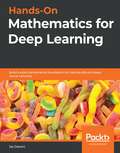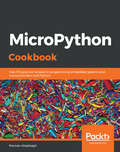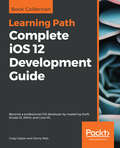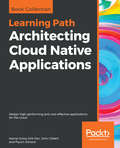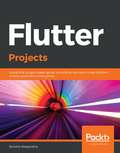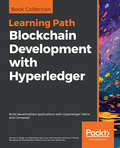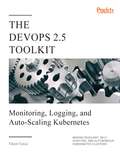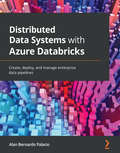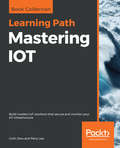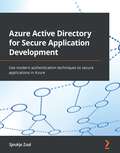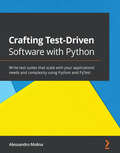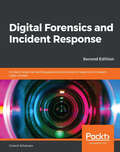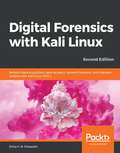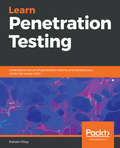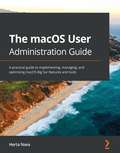- Table View
- List View
Nmap Network Exploration and Security Auditing Cookbook: Network discovery and security scanning at your fingertips, 3rd Edition
by Paulino CalderonA complete reference guide to mastering Nmap and its scripting engine, covering practical tasks for IT personnel, security engineers, system administrators, and application security enthusiastsKey FeaturesLearn how to use Nmap and other tools from the Nmap family with the help of practical recipesDiscover the latest and most powerful features of Nmap and the Nmap Scripting EngineExplore common security checks for applications, Microsoft Windows environments, SCADA, and mainframesBook DescriptionNmap is one of the most powerful tools for network discovery and security auditing used by millions of IT professionals, from system administrators to cybersecurity specialists. This third edition of the Nmap: Network Exploration and Security Auditing Cookbook introduces Nmap and its family - Ncat, Ncrack, Ndiff, Zenmap, and the Nmap Scripting Engine (NSE) - and guides you through numerous tasks that are relevant to security engineers in today's technology ecosystems.The book discusses some of the most common and useful tasks for scanning hosts, networks, applications, mainframes, Unix and Windows environments, and ICS/SCADA systems. Advanced Nmap users can benefit from this book by exploring the hidden functionalities within Nmap and its scripts as well as advanced workflows and configurations to fine-tune their scans. Seasoned users will find new applications and third-party tools that can help them manage scans and even start developing their own NSE scripts. Practical examples featured in a cookbook format make this book perfect for quickly remembering Nmap options, scripts and arguments, and more.By the end of this Nmap book, you will be able to successfully scan numerous hosts, exploit vulnerable areas, and gather valuable information.What you will learnScan systems and check for the most common vulnerabilitiesExplore the most popular network protocolsExtend existing scripts and write your own scripts and librariesIdentify and scan critical ICS/SCADA systemsDetect misconfigurations in web servers, databases, and mail serversUnderstand how to identify common weaknesses in Windows environmentsOptimize the performance and improve results of scansWho this book is forThis Nmap cookbook is for IT personnel, security engineers, system administrators, application security enthusiasts, or anyone who wants to master Nmap and its scripting engine. This book is also recommended for anyone looking to learn about network security auditing, especially if they're interested in understanding common protocols and applications in modern systems. Advanced and seasoned Nmap users will also benefit by learning about new features, workflows, and tools. Basic knowledge of networking, Linux, and security concepts is required before taking up this book.
Hands-on JavaScript for Python Developers: Leverage your Python knowledge to quickly learn JavaScript and advance your web development career
by Sonyl NagaleBuild robust full-stack web applications using two of the world's most popular programming languages Python and JavaScript Key Features Discover similarities and differences between JavaScript and Python coding conventions Explore frontend web concepts, UI/UX techniques, and JavaScript frameworks to enhance your web development skills Put your JS knowledge into practice by developing a full-stack web app with React and Express Book Description Knowledge of Python is a great foundation for learning other languages. This book will help you advance in your software engineering career by leveraging your Python programming skills to learn JavaScript and apply its unique features not only for frontend web development but also for streamlining work on the backend. Starting with the basics of JavaScript, you'll cover its syntax, its use in the browser, and its frameworks and libraries. From working with user interactions and ingesting data from APIs through to creating APIs with Node.js, this book will help you get up and running with JavaScript using hands-on exercises, code snippets, and detailed descriptions of JavaScript implementation and benefits. To understand the use of JavaScript in the backend, you'll explore Node.js and discover how it communicates with databases. As you advance, you'll get to grips with creating your own RESTful APIs and connecting the frontend and backend for holistic full-stack development knowledge. By the end of this Python JavaScript book, you'll have the knowledge you need to write full-fledged web applications from start to finish. You'll have also gained hands-on experience of working through several projects, which will help you advance in your career as a JavaScript developer. What you will learn Discover the differences between Python and JavaScript at both the syntactical and semantical level Become well versed in implementing JavaScript in the frontend as well as the backend Understand the separation of concerns while using Python programming for server-side development Get to grips with frontend web development tasks, including UI/UX design, form validation, animations, and much more Create modern interaction interfaces for your Python web application Explore modern web technologies and libraries for building full-stack applications Who this book is for This book is for experienced Python programmers who are looking to expand their knowledge of frontend and backend web development with JavaScript. An understanding of data types, functions, and scope is necessary to get to grips with the concepts covered in the book. Familiarity with HTML and CSS, Document Object Model (DOM), and Flask or Django will help you to learn JavaScript easily.
PostgreSQL 13 Cookbook: Over 120 recipes to build high-performance and fault-tolerant PostgreSQL database solutions
by Vallarapu Naga KumarGet to grips with building reliable, scalable, and maintainable database solutions for enterprises and production databasesKey FeaturesImplement PostgreSQL 13 features to perform end-to-end modern database managementDesign, manage, and build enterprise database solutions using a unique recipe-based approachSolve common and not-so-common challenges faced while working to achieve optimal database performanceBook DescriptionPostgreSQL has become the most advanced open source database on the market. This book follows a step-by-step approach, guiding you effectively in deploying PostgreSQL in production environments. The book starts with an introduction to PostgreSQL and its architecture. You'll cover common and not-so-common challenges faced while designing and managing the database. Next, the book focuses on backup and recovery strategies to ensure your database is steady and achieves optimal performance. Throughout the book, you'll address key challenges such as maintaining reliability, data integrity, a fault-tolerant environment, a robust feature set, extensibility, consistency, and authentication. Moving ahead, you'll learn how to manage a PostgreSQL cluster and explore replication features for high availability. Later chapters will assist you in building a secure PostgreSQL server, along with covering recipes for encrypting data in motion and data at rest. Finally, you'll not only discover how to tune your database for optimal performance but also understand ways to monitor and manage maintenance activities, before learning how to perform PostgreSQL upgrades during downtime. By the end of this book, you'll be well-versed with the essential PostgreSQL 13 features to build enterprise relational databases.What you will learnUnderstand logical and physical backups in PostgresDemonstrate the different types of replication methods possible with PostgreSQL todaySet up a high availability cluster that provides seamless automatic failover for applicationsSecure a PostgreSQL encryption through authentication, authorization, and auditingAnalyze the live and historic activity of a PostgreSQL serverUnderstand how to monitor critical services in Postgres 13Manage maintenance activities and performance tuning of a PostgreSQL clusterWho this book is forThis PostgreSQL book is for database architects, database developers and administrators, or anyone who wants to become well-versed with PostgreSQL 13 features to plan, manage, and design efficient database solutions. Prior experience with the PostgreSQL database and SQL language is expected.
Developing Modern Database Applications with PostgreSQL: Use the highly available and object-relational PostgreSQL to build scalable and reliable apps
by Dr. Quan LeThis book is for database developers, database administrators, data architects, or anyone who wants to build end-to-end database projects using Postgres. This book will also appeal to software engineers, IT technicians, computer science researchers, and university students who are interested in database development and administration. Some familiarity with PostgreSQL and Linux is required to grasp the concepts covered in the book effectively.
Learn Computer Forensics: A beginner's guide to searching, analyzing, and securing digital evidence
by William OettingerGet up and running with collecting evidence using forensics best practices to present your findings in judicial or administrative proceedingsKey FeaturesLearn the core techniques of computer forensics to acquire and secure digital evidence skillfullyConduct a digital forensic examination and document the digital evidence collectedPerform a variety of Windows forensic investigations to analyze and overcome complex challengesBook DescriptionA computer forensics investigator must possess a variety of skills, including the ability to answer legal questions, gather and document evidence, and prepare for an investigation. This book will help you get up and running with using digital forensic tools and techniques to investigate cybercrimes successfully.Starting with an overview of forensics and all the open source and commercial tools needed to get the job done, you'll learn core forensic practices for searching databases and analyzing data over networks, personal devices, and web applications. You'll then learn how to acquire valuable information from different places, such as filesystems, e-mails, browser histories, and search queries, and capture data remotely. As you advance, this book will guide you through implementing forensic techniques on multiple platforms, such as Windows, Linux, and macOS, to demonstrate how to recover valuable information as evidence. Finally, you'll get to grips with presenting your findings efficiently in judicial or administrative proceedings.By the end of this book, you'll have developed a clear understanding of how to acquire, analyze, and present digital evidence like a proficient computer forensics investigator.What you will learnUnderstand investigative processes, the rules of evidence, and ethical guidelinesRecognize and document different types of computer hardwareUnderstand the boot process covering BIOS, UEFI, and the boot sequenceValidate forensic hardware and softwareDiscover the locations of common Windows artifactsDocument your findings using technically correct terminologyWho this book is forIf you're an IT beginner, student, or an investigator in the public or private sector this book is for you. This book will also help professionals and investigators who are new to incident response and digital forensics and interested in making a career in the cybersecurity domain. Individuals planning to pass the Certified Forensic Computer Examiner (CFCE) certification will also find this book useful.
Learn Docker - Fundamentals of Docker 19.x: Build, test, ship, and run containers with Docker and Kubernetes, 2nd Edition
by Gabriel N. SchenkerExplore the core functionality of containerizing your applications and making them production-ready Key Features Grasp basic to advanced Docker concepts with this comprehensive guide Get acquainted with Docker containers, Docker images, orchestrators, cloud integration, and networking Learn to simplify dependencies and deploy and test containers in production Book Description Containers enable you to package an application with all the components it needs, such as libraries and other dependencies, and ship it as one package. Docker containers have revolutionized the software supply chain in both small and large enterprises. Starting with an introduction to Docker fundamentals and setting up an environment to work with it, you'll delve into concepts such as Docker containers, Docker images, and Docker Compose. As you progress, the book will help you explore deployment, orchestration, networking, and security. Finally, you'll get to grips with Docker functionalities on public clouds such as Amazon Web Services (AWS), Azure, and Google Cloud Platform (GCP), and learn about Docker Enterprise Edition features. Additionally, you'll also discover the benefits of increased security with the use of containers. By the end of this Docker book, you'll be able to build, ship, and run a containerized, highly distributed application on Docker Swarm or Kubernetes, running on-premises or in the cloud. What you will learn Containerize your traditional or microservice-based applications Develop, modify, debug, and test an application running inside a container Share or ship your application as an immutable container image Build a Docker Swarm and a Kubernetes cluster in the cloud Run a highly distributed application using Docker Swarm or Kubernetes Update or rollback a distributed application with zero downtime Secure your applications with encapsulation, networks, and secrets Troubleshoot a containerized, highly distributed application in the cloud Who this book is for This book is for system administrators, operations engineers, DevOps engineers, and developers or stakeholders who are interested in getting started with Docker from scratch. No prior experience with Docker containers is required.
Building Computer Vision Projects with OpenCV 4 and C++: Implement complex computer vision algorithms and explore deep learning and face detection
by Prateek Joshi Roy Shilkrot David Millán Escrivá Vinícius G. MendonçaDelve into practical computer vision and image processing projects and get up to speed with advanced object detection techniques and machine learning algorithmsKey FeaturesDiscover best practices for engineering and maintaining OpenCV projectsExplore important deep learning tools for image classificationUnderstand basic image matrix formats and filtersBook DescriptionOpenCV is one of the best open source libraries available and can help you focus on constructing complete projects on image processing, motion detection, and image segmentation.This Learning Path is your guide to understanding OpenCV concepts and algorithms through real-world examples and activities. Through various projects, you'll also discover how to use complex computer vision and machine learning algorithms and face detection to extract the maximum amount of information from images and videos. In later chapters, you'll learn to enhance your videos and images with optical flow analysis and background subtraction. Sections in the Learning Path will help you get to grips with text segmentation and recognition, in addition to guiding you through the basics of the new and improved deep learning modules. By the end of this Learning Path, you will have mastered commonly used computer vision techniques to build OpenCV projects from scratch. This Learning Path includes content from the following Packt books:Mastering OpenCV 4 - Third Edition by Roy Shilkrot and David Millán EscriváLearn OpenCV 4 By Building Projects - Second Edition by David Millán Escrivá, Vinícius G. Mendonça, and Prateek JoshiWhat you will learnStay up-to-date with algorithmic design approaches for complex computer vision tasksWork with OpenCV's most up-to-date API through various projectsUnderstand 3D scene reconstruction and Structure from Motion (SfM)Study camera calibration and overlay augmented reality (AR) using the ArUco moduleCreate CMake scripts to compile your C++ applicationExplore segmentation and feature extraction techniquesRemove backgrounds from static scenes to identify moving objects for surveillanceWork with new OpenCV functions to detect and recognize text with TesseractWho this book is forIf you are a software developer with a basic understanding of computer vision and image processing and want to develop interesting computer vision applications with OpenCV, this Learning Path is for you. Prior knowledge of C++ and familiarity with mathematical concepts will help you better understand the concepts in this Learning Path.
PyTorch Computer Vision Cookbook: Over 70 recipes to master the art of computer vision with deep learning and PyTorch 1.x
by Michael AvendiDiscover powerful ways to use deep learning algorithms and solve real-world computer vision problems using Python Key Features Solve the trickiest of problems in computer vision by combining the power of deep learning and neural networks Leverage PyTorch 1.x capabilities to perform image classification, object detection, and more Train and deploy enterprise-grade, deep learning models for computer vision applications Book Description Computer vision techniques play an integral role in helping developers gain a high-level understanding of digital images and videos. With this book, you'll learn how to solve the trickiest problems in computer vision (CV) using the power of deep learning algorithms, and leverage the latest features of PyTorch 1.x to perform a variety of CV tasks. Starting with a quick overview of the PyTorch library and key deep learning concepts, the book then covers common and not-so-common challenges faced while performing image recognition, image segmentation, object detection, image generation, and other tasks. Next, you'll understand how to implement these tasks using various deep learning architectures such as convolutional neural networks (CNNs), recurrent neural networks (RNNs), long short-term memory (LSTM), and generative adversarial networks (GANs). Using a problem-solution approach, you'll learn how to solve any issue you might face while fine-tuning the performance of a model or integrating it into your application. Later, you'll get to grips with scaling your model to handle larger workloads, and implementing best practices for training models efficiently. By the end of this CV book, you'll be proficient in confidently solving many CV related problems using deep learning and PyTorch. What you will learn Develop, train and deploy deep learning algorithms using PyTorch 1.x Understand how to fine-tune and change hyperparameters to train deep learning algorithms Perform various CV tasks such as classification, detection, and segmentation Implement a neural style transfer network based on CNNs and pre-trained models Generate new images and implement adversarial attacks using GANs Implement video classification models based on RNN, LSTM, and 3D-CNN Discover best practices for training and deploying deep learning algorithms for CV applications Who this book is for Computer vision professionals, data scientists, deep learning engineers, and AI developers looking for quick solutions for various computer vision problems will find this book useful. Intermediate-level knowledge of computer vision concepts, along with Python programming experience is required.
Hands-On Mathematics for Deep Learning: Build A Solid Mathematical Foundation For Training Efficient Deep Neural Networks
by Jay DawaniThis book is for data scientists, machine learning developers, aspiring deep learning developers or anyone who wants to understand the foundation of deep learning by learning the math behind it. Working knowledge of the Python programming language and machine learning basics is required.
MicroPython Cookbook: Over 110 practical recipes for programming embedded systems and microcontrollers with Python
by Marwan AlsabbaghLearn how you can control LEDs, make music, and read sensor data using popular microcontrollers such as Adafruit Circuit Playground, ESP8266, and the BBC micro:bitKey FeaturesLoad and execute your first program with MicroPythonProgram an IoT device to retrieve weather data using a RESTful APIGet to grips with integrating hardware, programming, and networking concepts with MicroPythonBook DescriptionMicroPython is an open source implementation of Python 3 that runs in embedded environments. With MicroPython, you can write clean and simple Python code to control hardware instead of using complex low-level languages such as C and C++. This book guides you through all the major applications of the MicroPython platform to build and program projects that use microcontrollers. This MicroPython book covers recipes that will help you experiment with the programming environment and hardware programmed in MicroPython. You'll find tips and techniques for building a variety of objects and prototypes that can sense and respond to touch, sound, position, heat, and light. This book will take you through the uses of MicroPython with a variety of popular input devices and sensors. You'll learn techniques to handle time delays and sensor readings, and apply advanced coding techniques to create complex projects. As you advance, you'll deal with Internet of Things (IoT) devices and integration with other online web services. In addition to this, you'll use MicroPython to make music with bananas and create portable multiplayer video games that incorporate sound and light animations into the gameplay. By the end of this book, you'll have mastered the tips and tricks to troubleshoot your development problems and take your MicroPython project to the next level.What you will learnExecute code without any need for compiling or uploading using REPL (read-evaluate-print-loop)Program and control LED matrix and NeoPixel drivers to display patterns and colorsBuild projects that make use of light, temperature, and touch sensorsConfigure devices to create Wi-Fi access points and use network modules to scan and connect to existing networksUse Pulse width modulation to control DC motors and servosBuild an IoT device to display live weather data from the internet at the touch of a buttonWho this book is forIf you want to build and program projects that use microcontrollers, this book will offer you dozens of recipes to guide you through all the major applications of the MicroPython platform. Although no knowledge of MicroPython or microcontrollers is expected, a general understanding of Python is necessary to get started with this book.
Complete iOS 12 Development Guide: Become a professional iOS developer by mastering Swift, Xcode 10, ARKit, and Core ML
by Donny Wals Craig ClaytonLearn to create professional-grade iOS applications for the App Store using the latest iOS 12 features and other helpful tools Key Features Explore the distinctive design principles that define the iOS user experience Train and use machine learning models with Core ML 2 and Create ML Delve into advanced animations with UIViewPropertyAnimator and UIKitDynamics Book Description With Apple users spending more money in the App Store, there are plenty of development opportunities for professional iOS developers. This Learning Path is a direct route to iOS development, which will take you through the basics and help you put principles into practice. For experienced programmers, this book will help you gain insights into the latest iOS 12 features. This book is also useful for beginners who want to gain expertise in iOS development. You'll start with an introduction to iOS development, Xcode, and Swift. To give your app the edge, you'll get up to speed with advanced iOS topics, such as gestures and animations. Next, you will understand the latest Swift 4.2 and iOS 12 developments by incorporating new features, such as the latest in notifications, custom-UI notifications, maps, and recent additions in SiriKit. With these tools, you'll be able to write efficient, readable, and maintainable Swift code that maintains industry best practices. By the end of the book, you will have the confidence to build iOS 12 applications that harness advanced techniques and make the best use of the latest features. This Learning Path includes content from the following Packt products: iOS 12 Programming for Beginners - Third Edition by Craig Clayton Mastering iOS 12 Programming - Third Edition by Donny Wals What you will learn Build a responsive user interface (UI) and add privacy to your custom-rich notifications Set up SiriKit to add voice for Siri shortcuts Integrate iMessage, Siri, and more in your app through app extensions Use TestFlight to collect feedback before releasing your apps on the App Store Use Auto Layout to create complex layouts that look visually appealing on any device Enhance your app by building your own profiling tools Create engaging augmented reality experiences with ARKit 2 Who this book is for If you are completely new to Swift, iOS, or programming and want to become an expert in developing iOS applications, this Learning Path is for you. You'll also find this Learning Path useful if you're an experienced programmer looking to explore the latest iOS 12 features.
Architecting Cloud Native Applications: Design high-performing and cost-effective applications for the cloud
by John Gilbert Kamal Arora Erik Farr Piyum ZonoozApply cloud native patterns and practices to deliver responsive, resilient, elastic, and message-driven systems with confidence Key Features Discover best practices for applying cloud native patterns to your cloud applications Explore ways to effectively plan resources and technology stacks for high security and fault tolerance Gain insight into core architectural principles using real-world examples Book Description Cloud computing has proven to be the most revolutionary IT development since virtualization. Cloud native architectures give you the benefit of more flexibility over legacy systems. This Learning Path teaches you everything you need to know for designing industry-grade cloud applications and efficiently migrating your business to the cloud. It begins by exploring the basic patterns that turn your database inside out to achieve massive scalability. You'll learn how to develop cloud native architectures using microservices and serverless computing as your design principles. Then, you'll explore ways to continuously deliver production code by implementing continuous observability in production. In the concluding chapters, you'll learn about various public cloud architectures ranging from AWS and Azure to the Google Cloud Platform, and understand the future trends and expectations of cloud providers. By the end of this Learning Path, you'll have learned the techniques to adopt cloud native architectures that meet your business requirements. This Learning Path includes content from the following Packt products: Cloud Native Development Patterns and Best Practices by John Gilbert Cloud Native Architectures by Erik Farr et al. What you will learn Understand the difference between cloud native and traditional architecture Automate security controls and configuration management Minimize risk by evolving your monolithic systems into cloud native applications Explore the aspects of migration, when and why to use it Apply modern delivery and testing methods to continuously deliver production code Enable massive scaling by turning your database inside out Who this book is for This Learning Path is designed for developers who want to progress into building cloud native systems and are keen to learn the patterns involved. Software architects, who are keen on designing scalable and highly available cloud native applications, will also find this Learning Path very useful. To easily grasp these concepts, you will need basic knowledge of programming and cloud computing.
Flutter Projects: A practical, project-based guide to building real-world cross-platform mobile applications and games
by Simone AlessandriaLearn Flutter and the Dart programming language by building impressive real-world mobile applications for Android and iOS Key Features Learn cross-platform mobile development with Flutter and Dart by building 11 real-world apps Create wide array of mobile projects such as 2D game, productivity timer, movie browsing app, and more Practical projects demonstrating Flutter development techniques with tips, tricks, and best practices Book Description Flutter is a modern reactive mobile framework that removes a lot of the complexity found in building native mobile apps for iOS and Android. With Flutter, developers can now build fast and native mobile apps from a single codebase. This book is packed with 11 projects that will help you build your own mobile applications using Flutter. It begins with an introduction to Dart programming and explains how it can be used with the Flutter SDK to customize mobile apps. Each chapter contains instructions on how to build an independent app from scratch, and each project focuses on important Flutter features.From building Flutter Widgets and applying animations to using databases (SQLite and sembast) and Firebase, you'll build on your knowledge through the chapters. As you progress, you'll learn how to connect to remote services, integrate maps, and even use Flare to create apps and games in Flutter. Gradually, you'll be able to create apps and games that are ready to be published on the Google Play Store and the App Store. In the concluding chapters, you'll learn how to use the BLoC pattern and various best practices related to creating enterprise apps with Flutter. By the end of this book, you will have the skills you need to write and deliver fully functional mobile apps using Flutter. What you will learn Design reusable mobile architectures that can be applied to apps at any scale Get up to speed with error handling and debugging for mobile application development Apply the principle of ңomposition over inheritance' to break down complex problems into many simple problems Update your code and see the results immediately using Flutter's hot reload Identify and prevent bugs from reappearing with Flutter's developer tools Manage an app's state with Streams and the BLoC pattern Build a simple web application using Flutter Web Who this book is for This book is for mobile developers and software developers who want to learn Flutter to build state-of-the-art mobile apps. Although prior experience with Dart programming or Flutter is not required, knowledge of object-oriented programming (OOP), data structures and software design patterns will be beneficial.
Blockchain Development with Hyperledger: Build decentralized applications with Hyperledger Fabric and Composer
by Luc Desrosiers Nitin Gaur Petr Novotny Venkatraman Ramakrishna Anthony O'Dowd Weimin Sun Xun (Brian) Wu Salman A. BasetLearn quick and effective techniques for developing blockchain-based distributed ledgers with easeKey FeaturesDiscover why blockchain is a game changer in the technology landscapeSet up blockchain networks using Hyperledger FabricWrite smart contracts at speed with Hyperledger ComposerBook DescriptionBlockchain and Hyperledger are open source technologies that power the development of decentralized applications. This Learning Path is your helpful reference for exploring and building blockchain networks using Ethereum, Hyperledger Fabric, and Hyperledger Composer.Blockchain Development with Hyperledger will start off by giving you an overview of blockchain and demonstrating how you can set up an Ethereum development environment for developing, packaging, building, and testing campaign-decentralized applications. You'll then explore the de facto language Solidity, which you can use to develop decentralized applications in Ethereum. Following this, you'll be able to configure Hyperledger Fabric and use it to build private blockchain networks and applications that connect to them. Toward the later chapters, you'll learn how to design and launch a network, and even implement smart contracts in chain code. By the end of this Learning Path, you'll be able to build and deploy your own decentralized applications by addressing the key pain points encountered in the blockchain life cycle.This Learning Path includes content from the following Packt products:Blockchain Quick Start Guide by Xun (Brian) Wu and Weimin SunHands-On Blockchain with Hyperledger by Nitin Gaur et al.What you will learnUnderstand why decentralized applications are necessaryDevelop and test a decentralized application with Hyperledger Fabric and Hyperledger ComposerWrite and test a smart contract using SolidityDesign transaction models and chain code with GolangDeploy the Composer REpresentational State Transfer (REST) Gateway to access Composer transactionsMaintain, monitor, and manage your blockchain solutionsWho this book is forThis Learning Path is designed for blockchain developers who want to build decentralized applications and smart contracts from scratch using Hyperledger. Basic familiarity with or exposure to any programming language will be useful to get started with this course.
The DevOps 2.5 Toolkit: Monitoring, Logging, and Auto-Scaling Kubernetes: Making Resilient, Self-Adaptive, And Autonomous Kubernetes Clusters (The\devops Toolkit Ser.)
by Viktor FarcicAn advanced exploration of the skills and knowledge required for operating Kubernetes clusters, with a focus on metrics gathering and alerting, with the goal of making clusters and applications inside them autonomous through self-healing and self-adaptation. Key Features The sixth book of DevOps expert Viktor Farcic's bestselling DevOps Toolkit series, with an overview of advanced core Kubernetes techniques,-oriented towards monitoring and alerting. Takes a deep dive into monitoring, alerting, logging, auto-scaling, and other subjects aimed at making clusters resilient, self-sufficient, and self-adaptive Discusses how to customise and create dashboards and alerts Book Description Building on The DevOps 2.3 Toolkit: Kubernetes, and The DevOps 2.4 Toolkit: Continuous Deployment to Kubernetes, Viktor Farcic brings his latest exploration of the Docker technology as he records his journey to monitoring, logging, and autoscaling Kubernetes. The DevOps 2.5 Toolkit: Monitoring, Logging, and Auto-Scaling Kubernetes: Making Resilient, Self-Adaptive, And Autonomous Kubernetes Clusters is the latest book in Viktor Farcic's series that helps you build a full DevOps Toolkit. This book helps readers develop the necessary skillsets needed to be able to operate Kubernetes clusters, with a focus on metrics gathering and alerting with the goal of making clusters and applications inside them autonomous through self-healing and self-adaptation. Work with Viktor and dive into the creation of self-adaptive and self-healing systems within Kubernetes. What you will learn Autoscaling Deployments and Statefulsets based on resource usage Autoscaling nodes of a Kubernetes cluster Debugging issues discovered through metrics and alerts Extending HorizontalPodAutoscaler with custom metrics Visualizing metrics and alerts Collecting and querying logs Who this book is for Readers with an advanced-level understanding of Kubernetes and hands-on experience.
Distributed Data Systems with Azure Databricks: Create, deploy, and manage enterprise data pipelines
by Alan Bernardo PalacioQuickly build and deploy massive data pipelines and improve productivity using Azure DatabricksKey FeaturesGet to grips with the distributed training and deployment of machine learning and deep learning modelsLearn how ETLs are integrated with Azure Data Factory and Delta LakeExplore deep learning and machine learning models in a distributed computing infrastructureBook DescriptionMicrosoft Azure Databricks helps you to harness the power of distributed computing and apply it to create robust data pipelines, along with training and deploying machine learning and deep learning models. Databricks' advanced features enable developers to process, transform, and explore data. Distributed Data Systems with Azure Databricks will help you to put your knowledge of Databricks to work to create big data pipelines. The book provides a hands-on approach to implementing Azure Databricks and its associated methodologies that will make you productive in no time. Complete with detailed explanations of essential concepts, practical examples, and self-assessment questions, you'll begin with a quick introduction to Databricks core functionalities, before performing distributed model training and inference using TensorFlow and Spark MLlib. As you advance, you'll explore MLflow Model Serving on Azure Databricks and implement distributed training pipelines using HorovodRunner in Databricks. Finally, you'll discover how to transform, use, and obtain insights from massive amounts of data to train predictive models and create entire fully working data pipelines. By the end of this MS Azure book, you'll have gained a solid understanding of how to work with Databricks to create and manage an entire big data pipeline.What you will learnCreate ETLs for big data in Azure DatabricksTrain, manage, and deploy machine learning and deep learning modelsIntegrate Databricks with Azure Data Factory for extract, transform, load (ETL) pipeline creationDiscover how to use Horovod for distributed deep learningFind out how to use Delta Engine to query and process data from Delta LakeUnderstand how to use Data Factory in combination with DatabricksUse Structured Streaming in a production-like environmentWho this book is forThis book is for software engineers, machine learning engineers, data scientists, and data engineers who are new to Azure Databricks and want to build high-quality data pipelines without worrying about infrastructure. Knowledge of Azure Databricks basics is required to learn the concepts covered in this book more effectively. A basic understanding of machine learning concepts and beginner-level Python programming knowledge is also recommended.
Developing IoT Projects with ESP32: Automate your home or business with inexpensive Wi-Fi devices
by Vedat Ozan OnerMaster the technique of using ESP32 as an edge device in any IoT application where wireless communication can make life easierKey FeaturesGain practical experience in working with ESP32Learn to interface various electronic devices such as sensors, integrated circuits (ICs), and displaysApply your knowledge to build real-world automation projectsBook DescriptionDeveloping IoT Projects with ESP32 provides end-to-end coverage of secure data communication techniques from sensors to cloud platforms that will help you to develop production-grade IoT solutions by using the ESP32 SoC. You'll learn how to employ ESP32 in your IoT projects by interfacing with different sensors and actuators using different types of serial protocols.This book will show you how some projects require immediate output for end-users, and cover different display technologies as well as examples of driving different types of displays. The book features a dedicated chapter on cybersecurity packed with hands-on examples. As you progress, you'll get to grips with BLE technologies and BLE mesh networking and work on a complete smart home project where all nodes communicate over a BLE mesh. Later chapters will show you how IoT requires cloud connectivity most of the time and remote access to smart devices. You'll also see how cloud platforms and third-party integrations enable endless possibilities for your end-users, such as insights with big data analytics and predictive maintenance to minimize costs.By the end of this book, you'll have developed the skills you need to start using ESP32 in your next wireless IoT project and meet the project's requirements by building effective, efficient, and secure solutions.What you will learnExplore advanced use cases like UART communication, sound and camera features, low-energy scenarios, and scheduling with an RTOSAdd different types of displays in your projects where immediate output to users is requiredConnect to Wi-Fi and Bluetooth for local network communicationConnect cloud platforms through different IoT messaging protocolsIntegrate ESP32 with third-party services such as voice assistants and IFTTTDiscover best practices for implementing IoT security features in a production-grade solutionWho this book is forIf you are an embedded software developer, an IoT software architect or developer, a technologist, or anyone who wants to learn how to use ESP32 and its applications, this book is for you. A basic understanding of embedded systems, programming, networking, and cloud computing concepts is necessary to get started with the book.
Mastering IOT: Build modern IoT solutions that secure and monitor your IoT infrastructure
by Perry Lea Colin DowLeverage the full potential of IoT with the combination of Raspberry Pi 3 and Python and architect a complete IoT system that is the best fit for your organization Key Features Build complex Python-based applications with IoT Explore different concepts, technologies, and tradeoffs in the IoT architectural stack Delve deep into each element of the IoT design—from sensors to the cloud Book Description The Internet of Things (IoT) is the fastest growing technology market. Industries are embracing IoT technologies to improve operational expenses, product life, and people's well-being. We'll begin our journey with an introduction to Raspberry Pi and quickly jump right into Python programming. We'll learn all concepts through multiple projects, and then reinforce our learnings by creating an IoT robot car. We'll examine modern sensor systems and focus on what their power and functionality can bring to our system. We'll also gain insight into cloud and fog architectures, including the OpenFog standards. The Learning Path will conclude by discussing three forms of prevalent attacks and ways to improve the security of our IoT infrastructure. By the end of this Learning Path, we will have traversed the entire spectrum of technologies needed to build a successful IoT system, and will have the confidence to build, secure, and monitor our IoT infrastructure. This Learning Path includes content from the following Packt products: Internet of Things Programming Projects by Colin Dow Internet of Things for Architects by Perry Lea What you will learn Build a home security dashboard using an infrared motion detector Receive data and display it with an actuator connected to the Raspberry Pi Build an IoT robot car that is controlled via the Internet Use IP-based communication to easily and quickly scale your system Explore cloud protocols, such as Message Queue Telemetry Transport (MQTT) and CoAP Secure communication with encryption forms, such as symmetric key Who this book is for This Learning Path is designed for developers, architects, and system designers who are interested in building exciting projects with Python by understanding the IoT ecosphere, various technologies, and tradeoffs. Technologists and technology managers who want to develop a broad view of IoT architecture, will also find this Learning Path useful. Prior programming knowledge of Python is a must.
Azure Active Directory for Secure Application Development: Use modern authentication techniques to secure applications in Azure
by Sjoukje ZaalDevelop secure applications using different features of Azure Active Directory along with modern authentication techniques and protocolsKey FeaturesConfidently secure your Azure applications using the tools offered by Azure ADGet to grips with the most modern and effective authorization and authentication protocolsUnlock the potential of Azure AD's most advanced features including Microsoft Graph and Azure AD B2CBook DescriptionAzure Active Directory for Secure Application Development is your one-stop shop for learning how to develop secure applications using modern authentication techniques with Microsoft Azure AD. Whether you're working with single-tenant, multi-tenant, or line-of-business applications, this book contains everything you need to secure them.The book wastes no time in diving into the practicalities of Azure AD. Right from the start, you'll be setting up tenants, adding users, and registering your first application in Azure AD. The balance between grasping and applying theory is maintained as you move from the intermediate to the advanced: from the basics of OAuth to getting your hands dirty with building applications and registering them in Azure AD. Want to pin down the Microsoft Graph, Azure AD B2C, or authentication protocol best practices? We've got you covered. The full range of Azure AD functionality from a developer perspective is here for you to explore with confidence.By the end of this secure app development book, you'll have developed the skill set that so many organizations are clamoring for. Security is mission-critical, and after reading this book, you will be too.What you will learnGet an overview of Azure AD and set up your Azure AD instanceMaster application configuration and the use of service principalsUnderstand new authentication protocolsExplore the Microsoft Identity librariesUse OpenID Connect, OAuth 2.0, and MSAL to make sign-in fully secureBuild a custom app that leverages the Microsoft Graph APIDeploy Azure AD B2C to meet your security requirementsCreate user flows and policies in Azure AD B2CWho this book is forIf you are a developer or architect who has basic knowledge of Azure Active Directory and are looking to gain expertise in the application security domain, this is the book for you. Basic Azure knowledge and experience in building web applications and web APIs in C# will help you get the most out of this book.
Crafting Test-Driven Software with Python: Write test suites that scale with your applications' needs and complexity using Python and PyTest
by Alessandro MolinaGet to grips with essential concepts and step-by-step explanations to apply TDD practices to your Python projects while keeping your test suite under controlKey FeaturesBuild robust Python applications using TDD and BDD methodologiesTest Python web applications using WebTest and web frameworksLeverage PyTest to implement stringent testing mechanisms to ensure fault-tolerant applicationsBook DescriptionTest-driven development (TDD) is a set of best practices that helps developers to build more scalable software and is used to increase the robustness of software by using automatic tests. This book shows you how to apply TDD practices effectively in Python projects. You'll begin by learning about built-in unit tests and Mocks before covering rich frameworks like PyTest and web-based libraries such as WebTest and Robot Framework, discovering how Python allows you to embrace all modern testing practices with ease. Moving on, you'll find out how to design tests and balance them with new feature development and learn how to create a complete test suite with PyTest. The book helps you adopt a hands-on approach to implementing TDD and associated methodologies that will have you up and running and make you more productive in no time. With the help of step-by-step explanations of essential concepts and practical examples, you'll explore automatic tests and TDD best practices and get to grips with the methodologies and tools available in Python for creating effective and robust applications. By the end of this Python book, you will be able to write reliable test suites in Python to ensure the long-term resilience of your application using the range of libraries offered by Python for testing and development.What you will learnFind out how tests can make your life easier as a developer and discover related best practicesExplore PyTest, the most widespread testing framework for PythonGet to grips with the most common PyTest plugins, including coverage, flaky, xdist, and pickedWrite functional tests for WSGI web applications with WebTestRun end-to-end tests for web applications using Robot FrameworkUnderstand what test-driven development means and why it is importantDiscover how to use the range of tools available in PythonBuild reliable and robust applicationsWho this book is forThis book is for Python developers looking to get started with test-driven development and developers who want to learn about the testing tools available in Python. Developers who want to create web applications with Python and plan to implement TDD methodology with PyTest will find this book useful. Basic knowledge of Python programming is required.
Digital Forensics and Incident Response: Incident response techniques and procedures to respond to modern cyber threats, 2nd Edition
by Gerard JohansenBuild your organization's cyber defense system by effectively implementing digital forensics and incident management techniquesKey FeaturesCreate a solid incident response framework and manage cyber incidents effectivelyPerform malware analysis for effective incident responseExplore real-life scenarios that effectively use threat intelligence and modeling techniquesBook DescriptionAn understanding of how digital forensics integrates with the overall response to cybersecurity incidents is key to securing your organization's infrastructure from attacks. This updated second edition will help you perform cutting-edge digital forensic activities and incident response.After focusing on the fundamentals of incident response that are critical to any information security team, you'll move on to exploring the incident response framework. From understanding its importance to creating a swift and effective response to security incidents, the book will guide you with the help of useful examples. You'll later get up to speed with digital forensic techniques, from acquiring evidence and examining volatile memory through to hard drive examination and network-based evidence. As you progress, you'll discover the role that threat intelligence plays in the incident response process. You'll also learn how to prepare an incident response report that documents the findings of your analysis. Finally, in addition to various incident response activities, the book will address malware analysis, and demonstrate how you can proactively use your digital forensic skills in threat hunting.By the end of this book, you'll have learned how to efficiently investigate and report unwanted security breaches and incidents in your organization.What you will learnCreate and deploy an incident response capability within your own organizationPerform proper evidence acquisition and handlingAnalyze the evidence collected and determine the root cause of a security incidentBecome well-versed with memory and log analysisIntegrate digital forensic techniques and procedures into the overall incident response processUnderstand the different techniques for threat huntingWrite effective incident reports that document the key findings of your analysisWho this book is forThis book is for cybersecurity and information security professionals who want to implement digital forensics and incident response in their organization. You will also find the book helpful if you are new to the concept of digital forensics and are looking to get started with the fundamentals. A basic understanding of operating systems and some knowledge of networking fundamentals are required to get started with this book.
Digital Forensics and Incident Response: Incident response techniques and procedures to respond to modern cyber threats
by Gerard JohansenBuild your organization's cyber defense system by effectively implementing digital forensics and incident management techniquesKey FeaturesCreate a solid incident response framework and manage cyber incidents effectivelyPerform malware analysis for effective incident responseExplore real-life scenarios that effectively use threat intelligence and modeling techniquesBook DescriptionAn understanding of how digital forensics integrates with the overall response to cybersecurity incidents is key to securing your organization's infrastructure from attacks. This updated second edition will help you perform cutting-edge digital forensic activities and incident response. After focusing on the fundamentals of incident response that are critical to any information security team, you’ll move on to exploring the incident response framework. From understanding its importance to creating a swift and effective response to security incidents, the book will guide you with the help of useful examples. You’ll later get up to speed with digital forensic techniques, from acquiring evidence and examining volatile memory through to hard drive examination and network-based evidence. As you progress, you’ll discover the role that threat intelligence plays in the incident response process. You’ll also learn how to prepare an incident response report that documents the findings of your analysis. Finally, in addition to various incident response activities, the book will address malware analysis, and demonstrate how you can proactively use your digital forensic skills in threat hunting. By the end of this book, you’ll have learned how to efficiently investigate and report unwanted security breaches and incidents in your organization.What you will learnCreate and deploy an incident response capability within your own organizationPerform proper evidence acquisition and handlingAnalyze the evidence collected and determine the root cause of a security incidentBecome well-versed with memory and log analysisIntegrate digital forensic techniques and procedures into the overall incident response processUnderstand the different techniques for threat huntingWrite effective incident reports that document the key findings of your analysisWho this book is forThis book is for cybersecurity and information security professionals who want to implement digital forensics and incident response in their organization. You will also find the book helpful if you are new to the concept of digital forensics and are looking to get started with the fundamentals. A basic understanding of operating systems and some knowledge of networking fundamentals are required to get started with this book.
Digital Forensics with Kali Linux: Perform data acquisition, data recovery, network forensics, and malware analysis with Kali Linux, 2nd Edition
by Shiva V. ParasramTake your forensic abilities and investigation skills to the next level using powerful tools that cater to all aspects of digital forensic investigations, right from hashing to reporting Key Features Perform evidence acquisition, preservation, and analysis using a variety of Kali Linux tools Use PcapXray to perform timeline analysis of malware and network activity Implement the concept of cryptographic hashing and imaging using Kali Linux Book Description Kali Linux is a Linux-based distribution that's widely used for penetration testing and digital forensics. It has a wide range of tools to help for digital forensics investigations and incident response mechanisms. This updated second edition of Digital Forensics with Kali Linux covers the latest version of Kali Linux and The Sleuth Kit. You'll get to grips with modern techniques for analysis, extraction, and reporting using advanced tools such as FTK Imager, hex editor, and Axiom. Updated to cover digital forensics basics and advancements in the world of modern forensics, this book will also delve into the domain of operating systems. Progressing through the chapters, you'll explore various formats for file storage, including secret hiding places unseen by the end user or even the operating system. The book will also show you how to create forensic images of data and maintain integrity using hashing tools. Finally, you'll cover advanced topics such as autopsies and acquiring investigation data from networks, operating system memory, and quantum cryptography. By the end of this book, you'll have gained hands-on experience of implementing all the pillars of digital forensics: acquisition, extraction, analysis, and presentation, all using Kali Linux tools. What you will learn Get up and running with powerful Kali Linux tools for digital investigation and analysis Perform internet and memory forensics with Volatility and Xplico Understand filesystems, storage, and data fundamentals Become well-versed with incident response procedures and best practices Perform ransomware analysis using labs involving actual ransomware Carry out network forensics and analysis using NetworkMiner and other tools Who this book is for This Kali Linux book is for forensics and digital investigators, security analysts, or anyone interested in learning digital forensics using Kali Linux. Basic knowledge of Kali Linux will be helpful to gain a better understanding of the concepts covered.
Learn Penetration Testing: Understand the art of penetration testing and develop your white hat hacker skills
by Rishalin PillayGet up to speed with various penetration testing techniques and resolve security threats of varying complexityKey FeaturesEnhance your penetration testing skills to tackle security threatsLearn to gather information, find vulnerabilities, and exploit enterprise defensesNavigate secured systems with the most up-to-date version of Kali Linux (2019.1) and Metasploit (5.0.0)Book DescriptionSending information via the internet is not entirely private, as evidenced by the rise in hacking, malware attacks, and security threats. With the help of this book, you'll learn crucial penetration testing techniques to help you evaluate enterprise defenses.You'll start by understanding each stage of pentesting and deploying target virtual machines, including Linux and Windows. Next, the book will guide you through performing intermediate penetration testing in a controlled environment. With the help of practical use cases, you'll also be able to implement your learning in real-world scenarios. By studying everything from setting up your lab, information gathering and password attacks, through to social engineering and post exploitation, you'll be able to successfully overcome security threats. The book will even help you leverage the best tools, such as Kali Linux, Metasploit, Burp Suite, and other open source pentesting tools to perform these techniques. Toward the later chapters, you'll focus on best practices to quickly resolve security threats.By the end of this book, you'll be well versed with various penetration testing techniques so as to be able to tackle security threats effectivelyWhat you will learnPerform entry-level penetration tests by learning various concepts and techniquesUnderstand both common and not-so-common vulnerabilities from an attacker's perspectiveGet familiar with intermediate attack methods that can be used in real-world scenariosUnderstand how vulnerabilities are created by developers and how to fix some of them at source code levelBecome well versed with basic tools for ethical hacking purposesExploit known vulnerable services with tools such as MetasploitWho this book is forIf you’re just getting started with penetration testing and want to explore various security domains, this book is for you. Security professionals, network engineers, and amateur ethical hackers will also find this book useful. Prior knowledge of penetration testing and ethical hacking is not necessary.
The macOS User Administration Guide
by Herta NavaExplore the capabilities of macOS tools and architecture for support tasks and system administration to optimize your macOS environmentKey FeaturesDelve into macOS Big Sur, from installation to managing apps and optimizing your environmentGet to grips with system administration, along with monitoring, maintaining, and securing your systemsDiscover ways to secure your data, backup infrastructure, and explore hidden files and foldersBook DescriptionThis book is a practical guide for developers looking to understand the features and tools in macOS that make it a professional tool for system administration.You will understand the basics of system administration and later get up and running with monitoring, maintaining, and securing your systems. With practical examples and best practices, you will be able to build a backup infrastructure and virtual private network for your network. As you progress, you will understand how to secure your data and networks effectively by implementing various security strategies.By the end of this book, you’ll not only be well-versed with macOS features, administration tasks, and best practices but also be able to apply the concepts you learn to achieve professional Apple certifications such as Apple Certified Support Professional (ACSP).What you will learnUnderstand the fundamentals of the macOS system and architectureInstall, update, and configure your local macOS system and identify the stages of the startup processCreate and manage a local user account and set up your customized macOS environmentManage your file systems, storage, and permissionsExplore practices and techniques to work with apps, networks, and security for your Mac systemDelve into administration tasks such as managing service resources and peripherals Who This Book Is ForIf you are a system administrator, support and help desk technician or engineer, power user, or Mac user looking to develop your knowledge of macOS, then this system administration book is for you. The book assumes a general understanding of the macOS environment. Some knowledge of system administration tasks will be beneficial, but not mandatory.Table of ContentsOverview of the macOS system, architecture, and featuresInstalling and configuring macOSThe Startup ProcessUser Accounts ManagementManaging User Security and PrivacyThe macOS File System: Disks, Volumes, and PartitionsUnderstanding Ownership and PermissionsSystem Resources and ShortcutsUnderstanding Metadata and SearchingManaging Apps and DocumentsBackups and ArchivingNetworking in macOSUsing the Command LineUsing macOS Sharing ServicesManaging Security in macOSUsing the Command-LineAPPENDIX A: Troubleshooting Tips
